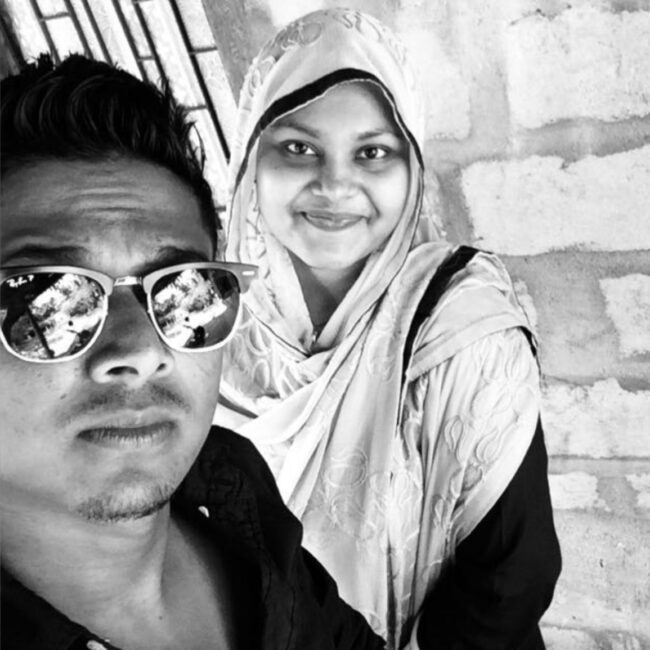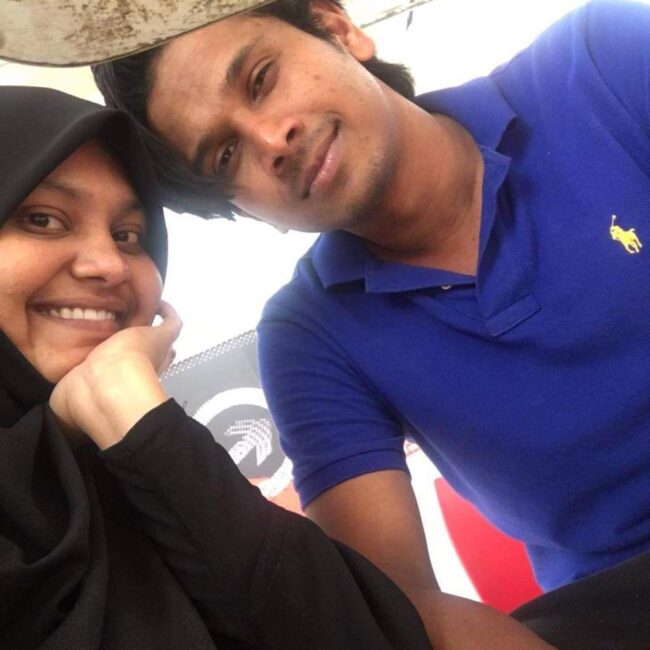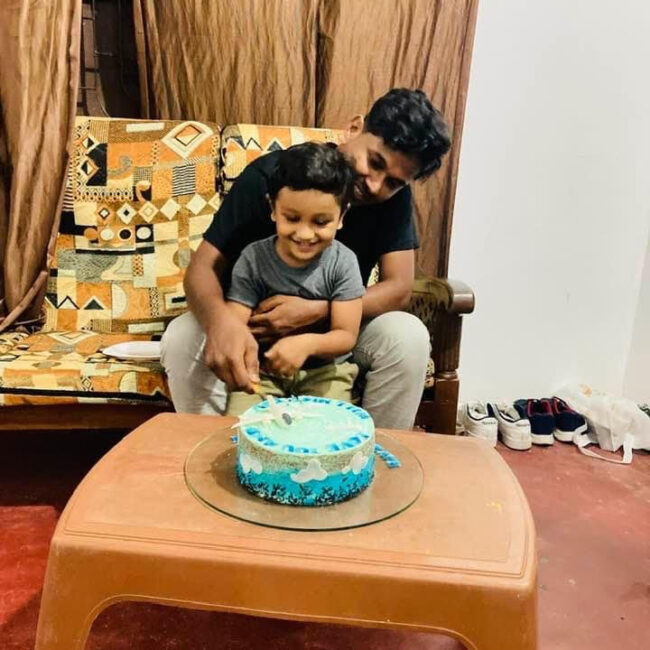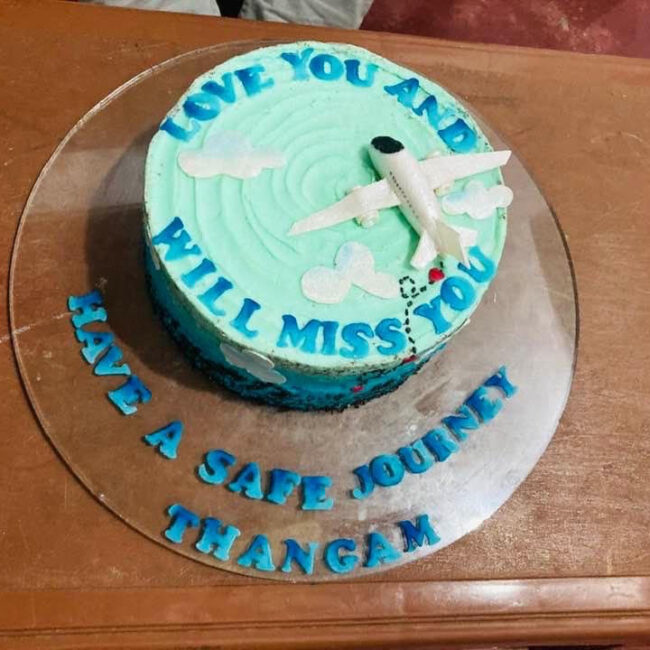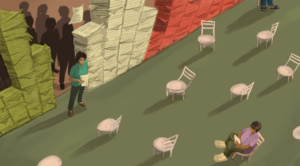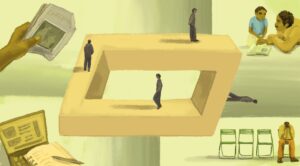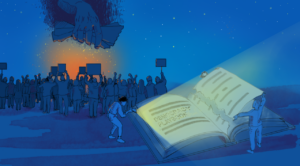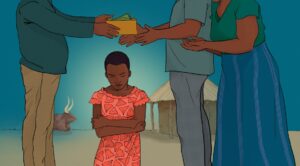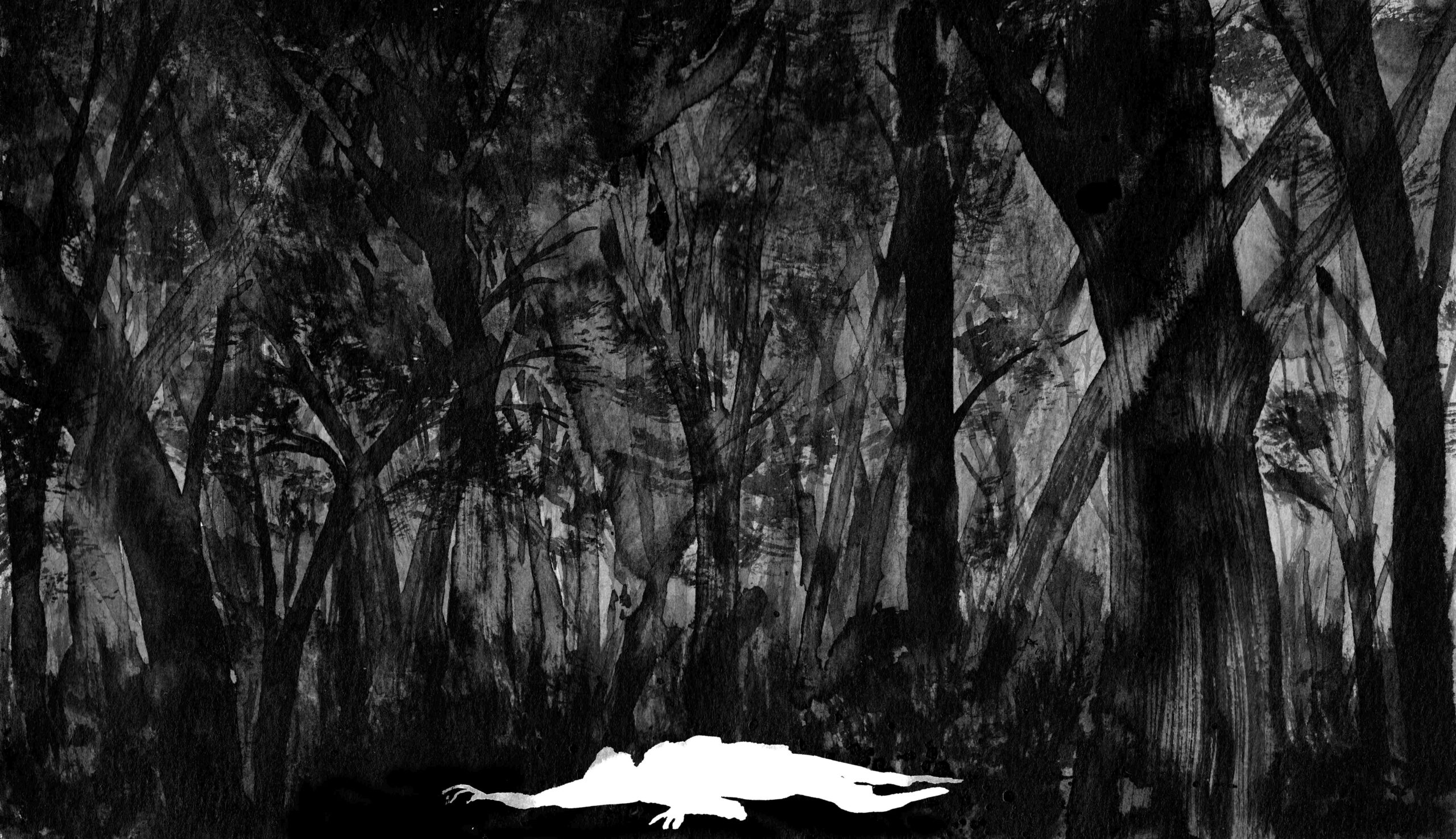
Widowed by Europe’s borders
- Written by Gabriela Ramirez and Tina Xu
- Illustration by Antoine Bouraly
- Edited by Tina Lee
“No water, I think I’ll die, I love you.” This is the last text Sanooja received from her husband, who disappeared after a pushback into the dense forest that stretches between Belarus, Lithuania, and Poland. For families searching for missing loved ones, the EU inflicts a second death of identity and acknowledgment.
Read this article in Lithuanian.
Samrin and Sanooja were high school classmates. Both born in 1990, they grew up together in Kalpitiya, a town of 80,000 on the tip of a small peninsula in Sri Lanka. When Samrin first asked Sanooja out in the ninth grade, she said no. But years later, when her roommates snuck through her diary, they asked about the boy in all her stories.
When they turned 20, Sanooja was studying to be a teacher, while Samrin left town for work. After six years of video calls and heart emoji-laden selfies, Samrin returned home in 2017 and they got married, her in a white headscarf and indigo-sleeved dress, him in a matching indigo suit. Their son Haashim was born a year later. They called each other “thangam,” or gold.
Sanooja laughs that her husband used to be “that guy who came to school with his hair gelled.” He first asked her out in the ninth grade, she became his girlfriend on “10/10/10,” and they got married on April 10, 2017. Photo: Shared by family.
She hoped the birth of their son meant that Samrin would stay close by from now on. They took their son to the beach, to the zoo. Then the 2019 economic crisis hit, the worst since the country’s independence in 1948. There were daily blackouts, a shortage of fuel, and runaway inflation. In 2022, protests rocked the country, and the government claimed bankruptcy.
Samrin was a difficult person to fall in love with, says Sanooja, because he was so ambitious. Sanooja smiles bitterly over a video call from her home in Kalpitiya. The sun filters through the mango tree in the yard, where the two often sat together and made plans for their future.
But part of loving him, she explains, meant supporting him even in his hardest decisions. One of these decisions was to take a plane to Moscow, then to travel to Europe and send money home. “He went to keep us happy, to make us good.”
Their last day together, Sanooja surprised him with a cake: Sky blue icing, an airplane made of fondant, ascending from an earth made of chocolate sprinkles. In big letters: “Love you and will miss you. Have a safe journey, Thangam.” In their last photos together, Haashim sits laughing on Samrin’s lap as he cuts the cake. That night, Samrin squeezed his son and wept. The next day he put on a pair of blue Converse All-Stars, packed a black backpack, and set out. It was June 26, 2022. He had just turned 32 years old.
Samrin and his son Haashim prepare to slice a cake made by his wife Sanooja on his last night at home. The cake reads: “Love you and will miss you. Have a safe journey, Thangam.”
Things did not go according to plan. He boarded a bus from St. Petersburg to Helsinki, but the fake Schengen visa they paid so much for was rejected at the Finnish border. Sanooja told him he could always come home. But in order to finance the journey, they had sold a plot of Samrin’s land and Sanooja’s jewelry, and borrowed money from friends. Samrin decided there was no turning back. He pivoted to plan B: He could go to Belarus, where he didn’t need a visa, and cross the border to Lithuania, in the Schengen zone.
When Samrin checked into the Old Town Trio Hotel in Vilnius on August 16, 2022, the first thing he did was call home: He had survived the forest. Sanooja was relieved to hear his voice. He told her about the eight days crossing the forest between Belarus and Lithuania, the mud up to his knees. Days without food, drinking dirty water. He told her especially about the pains in his stomach as he walked in the forest, due to his recent surgery to remove kidney stones. Sometimes he would urinate blood.
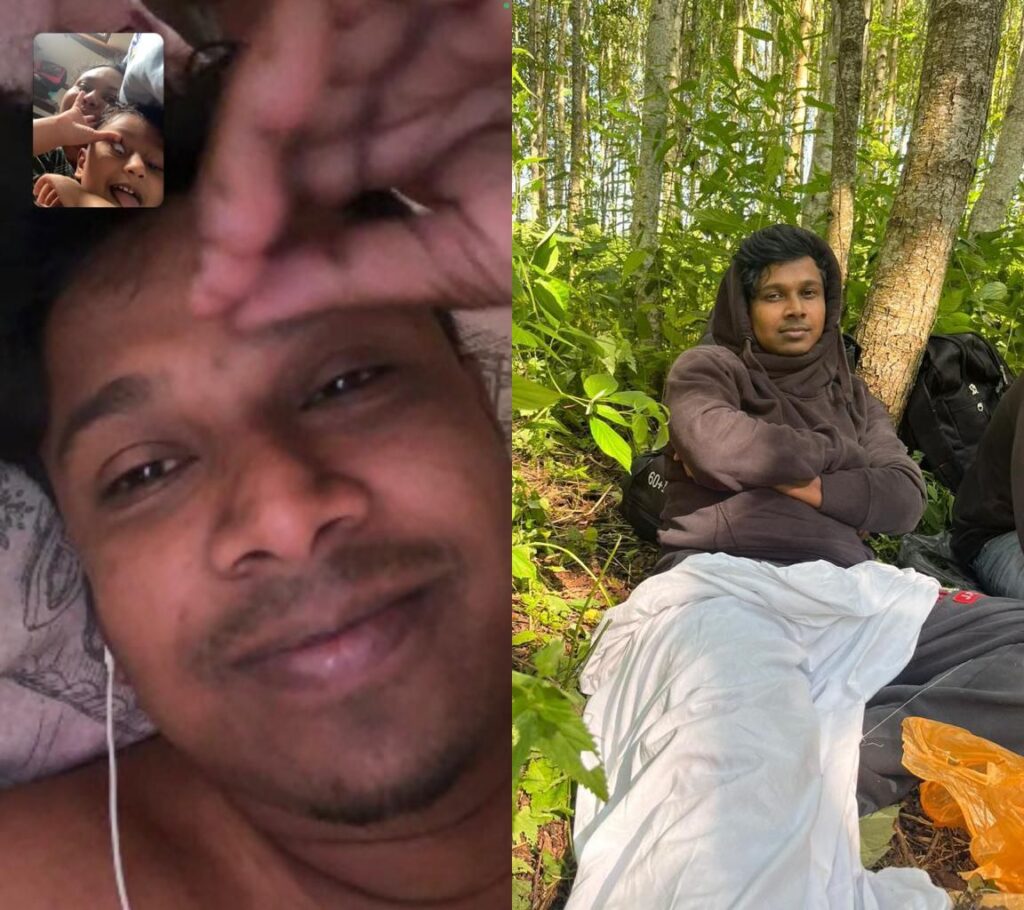
But he was in the European Union. He bought a plane ticket for a departure to Paris in four days, the city where he hoped to make his new life. What happened next is unclear. This is what Sanooja knows:
On the third day, Samrin walked into the hotel lobby, and the manager called security. Plainclothes officers shuttled him into a car and whisked him 50 kilometers back once more to the Belarusian border. In less than 72 hours, Samrin found himself trapped again in the forest he had fought to escape.
It was already dark when Samrin was left alone in the woods. He had no backpack, sleeping bag, or food. His phone was running out of battery. The next morning, Samrin came online briefly to send Sanooja a final message on WhatsApp: “No water, I think I’ll die. Trangam, I love you.”
That was the beginning of a deafening silence that stretched four and a half months. When she gets to this part of the story, Sanooja, ever talkative and articulate, apologizes that she simply cannot describe it. Her eyes glaze and flit upward.
The Council of Europe Human Rights Commissioner Dunja Mijatović asserts that families have a “right to truth” surrounding the fates of their loved ones who disappear en route to Europe. In 2021, the European Parliament passed a resolution calling for “prompt and effective identification processes” to connect the bodies of those who perished to those searching for them. Two years on, Mijatović tells us not much has been done, and the issue is a “legislative void.”
As part of the Border Graves Investigation, conducted with a cross-border team of eight freelance journalists across Europe in collaboration with Unbias the News, The Guardian and Süddeutsche Zeitung, we followed the stories of those more than 29,000 people who have died on European migration routes in the last decade, most of whose names remain unknown.
We verified 1,015 unmarked graves across 65 cemeteries, representing individuals who attempted to enter the EU and were laid to rest without identification along European borders in Poland, Lithuania, Greece, Spain, Italy, Malta, France, and Croatia.
We spoke with families, coroners, forensic scientists, NGOs and pathologists, as well as over a dozen humanitarian workers, lawyers, and policymakers to piece together the question of what happens after something goes fatally wrong on Europe’s borders—and who is responsible.
For this report we focused on those who have disappeared in the latest frontier of the European migration crisis: the forest that covers the borders between Belarus and the EU (Lithuania, Poland, Latvia).
Who counts the dead?
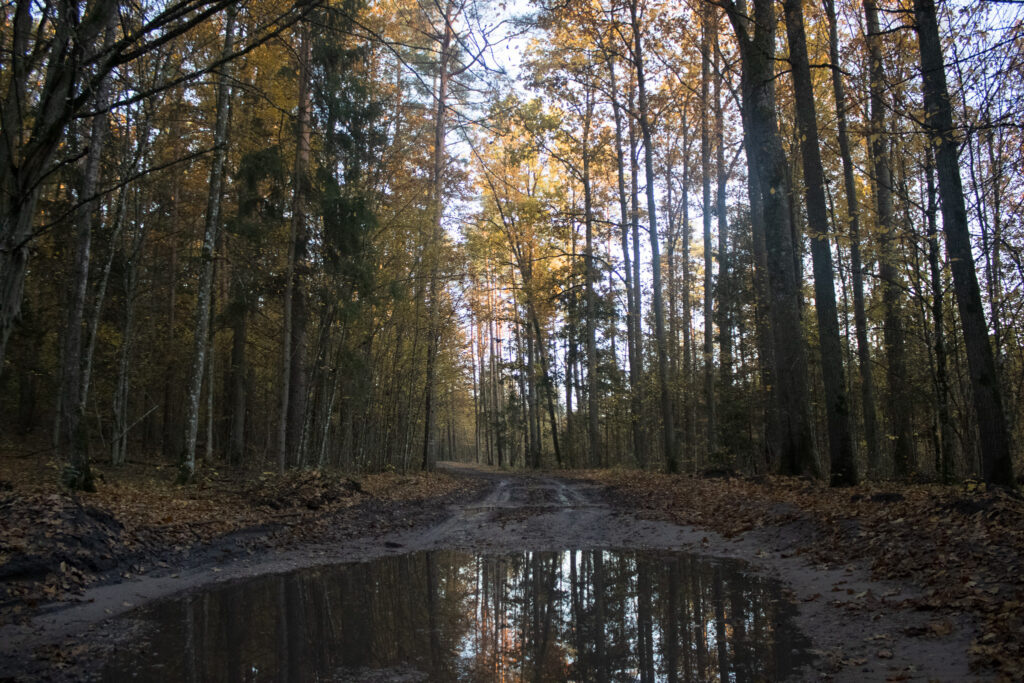
The forest along the Belarussian border is a dense landscape of underbrush, moss and swamps, and encompasses one of the largest ancient forest areas left in Europe.
Spanning hundreds of square kilometers across the borders with Lithuania and Poland, the forest became an unexpected hotspot when Belarus began issuing visas and opening direct flights to Minsk in the summer of 2021. This power play between Belarussian President Lukashenko and his EU neighbors has been called a “political game” in which migrants are the pawns.
Since 2021, thousands of people, mostly from the Middle East and Africa, have sought to enter the EU from Belarus via its borders in Poland and Lithuania. Hundreds of people have been caught in a one-kilometer no man’s land between Belarusian territory and the EU border fence, chased back and forth by border guards on both sides under threat of violence. Belarusian guards reportedly threatened to release dogs, and photographs emerged of bite wounds.
Since 2021, Poland and Lithuania have ramped up on “pushbacks,” in which border guards deport people immediately without the opportunity to ask for asylum, a process that is growing in popularity across Europe despite violating international law. Poland reports having conducted 78,010 pushbacks since the start of the crisis, and Lithuania 21,857. Samrin was apparently one of these cases.
While these two countries publish precise daily statistics for pushbacks, they do not publish data for deaths at the border, nor people reported missing.
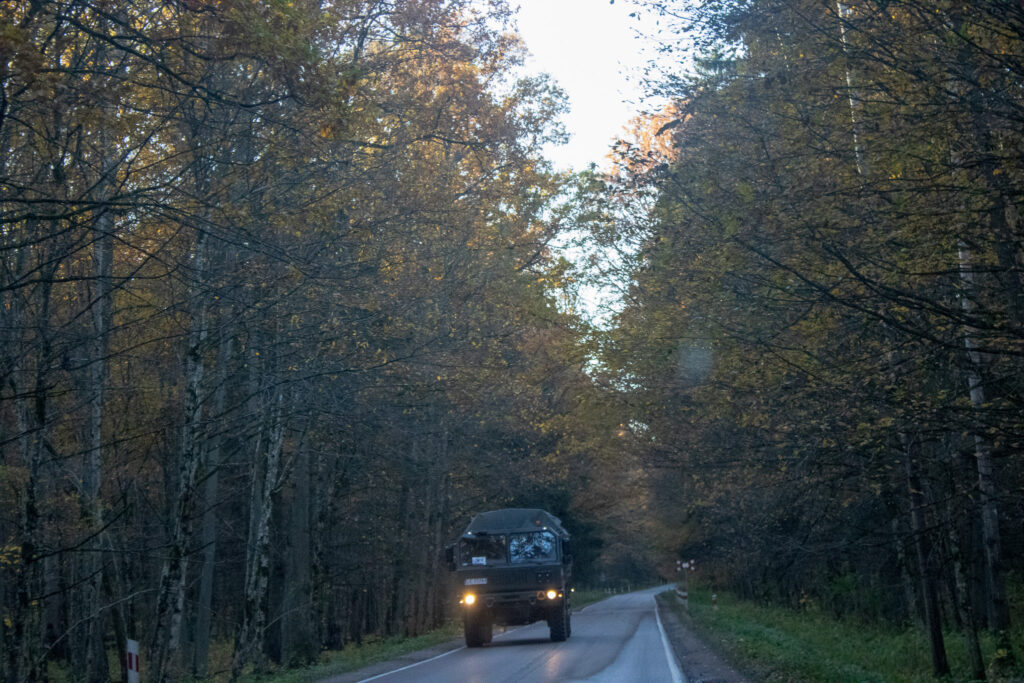
“National states want to do this job secretly,” explains Tomas Tomilinas, a member of the Lithuanian Parliament. “We are on the margins of the law and constitution here, any government pushing people back is trying to avoid publicity on this topic.”
Official data is an intentional void. Both the Polish and Lithuanian Border Guards declined to share any numbers with us. However, there are organizations striving to keep count: Humanitarian groups in Poland, including Grupa Granica (“Border Group” in Polish) and Podlaskie Humanitarian Emergency Service (POPH), have documented 52 deaths on the Poland-Belarus border since 2021, and are tracking 16 unidentified bodies.
In Lithuania, the humanitarian group Sienos Grupė (“Border Group” in Lithuanian) has documented 10 deaths, including three minors who died while in detention centers, and three others who died in car accidents when chased by local authorities after crossing the border region. In Belarus, the NGO Human Constanta reports that 33 have died according to government data shared with them, but it was not recorded whether these bodies have been identified, and whether or where they are buried.
On the borders between Poland, Lithuania and Belarus, humanitarian groups have compiled a list of more than 300 people reported missing. The organizations emphasize that their numbers are incomplete, as they have neither the access nor the capacity to monitor the full extent of the problem.
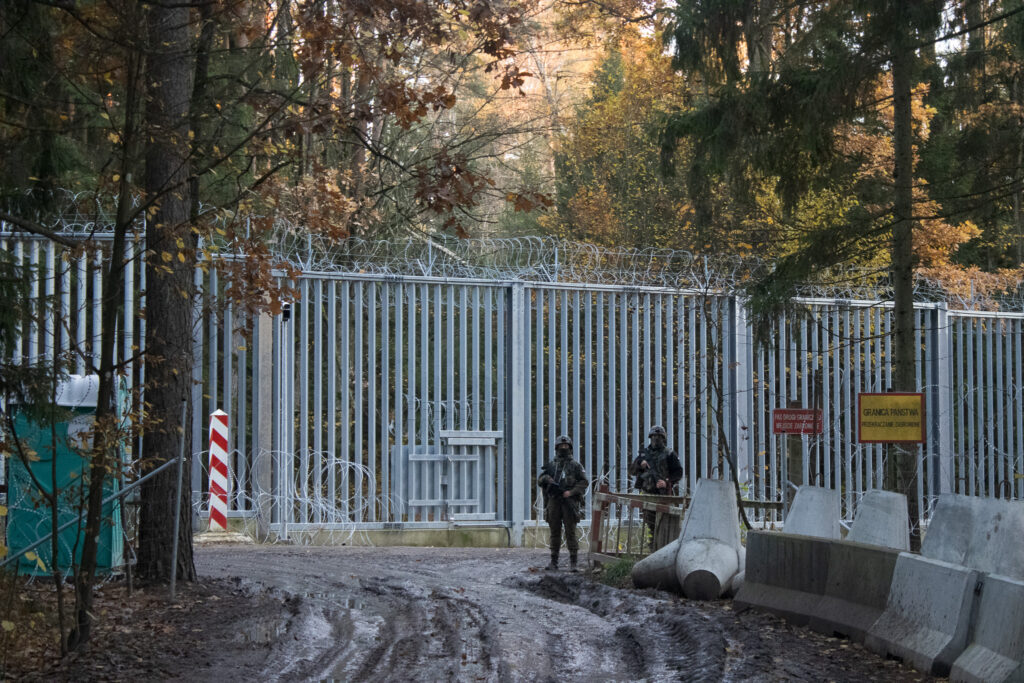
Where to turn?
It was already past midnight in Sri Lanka when Samrin stopped responding to messages. From 8,000 km away, Sanooja tried to call for help. She found his last known coordinates on Find My iPhone, a blue dot in Trokenikskiy, Grodno region, just across the Belarus side of the border, and tried to report him missing.
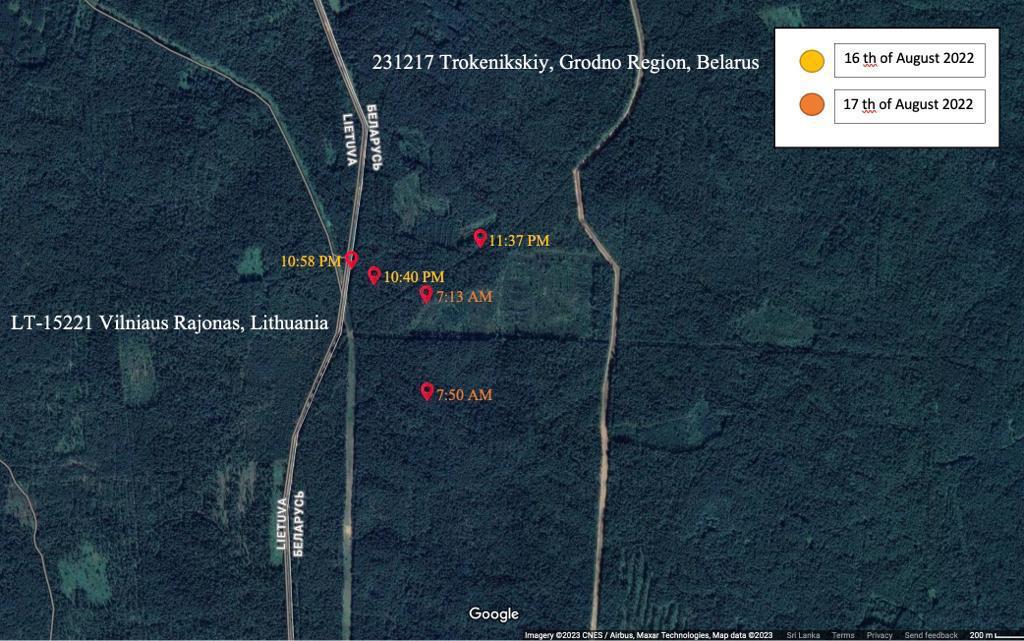
The Lithuanian and Belarussian border guards picked up the phone. She begged them to find him, even if it meant arresting or deporting him. They responded that he had to call himself. It was baffling: How can a missing person call to report themselves?
She called the migrant detention camps, where people are often detained without access to a phone for months. Maybe he was locked up somewhere. As soon as she said “hello,” they responded, “no English,” and hung up. She emailed them instead, no response. She emailed UNHCR and the Red Cross Society. Both institutions said they had no information about the case. She emailed the police, who responded a week later that they had no information.
Sanooja had run into the rude reality that there is no authority responsible for nor prepared to respond to such inquiries. Even organizations dedicated to working with migrants, such as the migrant detention camp staff, would or could not respond to basic queries in English.
International humanitarian organizations, too, are almost absent in the region. Compared to the Mediterranean countries of Spain, Italy, and Greece, which have had a decade to organize to respond to mass deaths on their border, the presence of formal aid in Eastern Europe is much smaller.
Weeks passed, and in the terrible silence, every possibility behind her husband’s disappearance invaded Sanooja’s mind. Four-year-old Haashim began to cry out for his father every night, who used to wake him up with kisses. When they lost contact, Haashim often wet the bed and refused to go to school. “He must have had some intuition about his father,” said Sanooja.
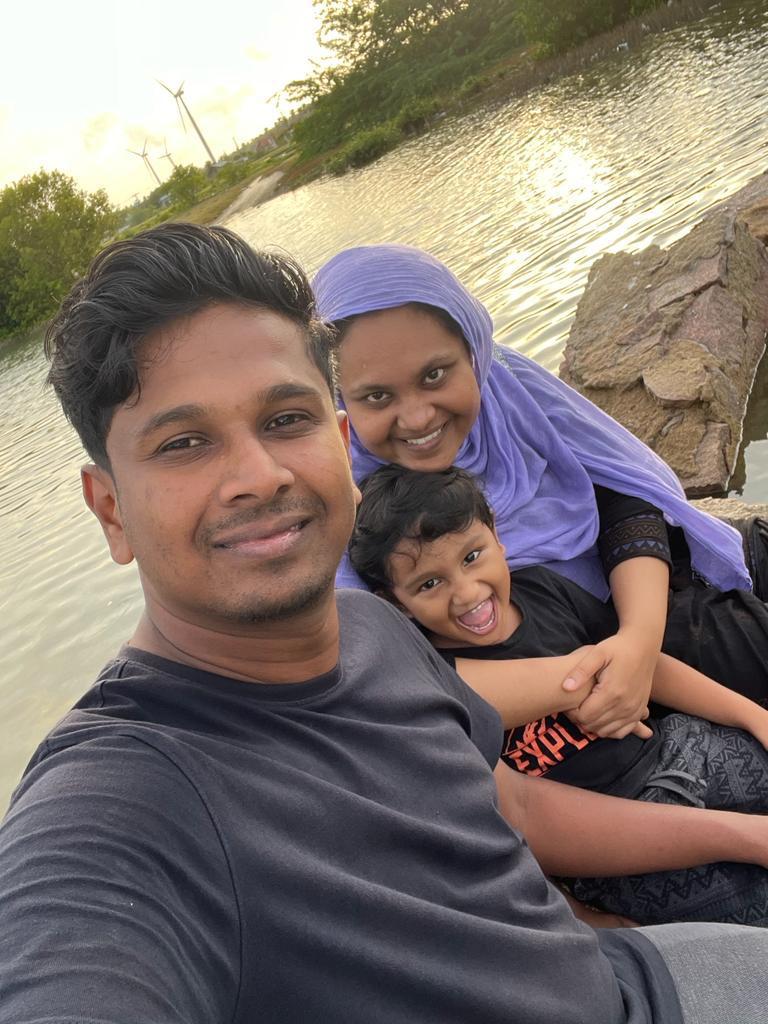
Then Sanooja began to wonder if he could be in another country in the region: Latvia? Poland? She broadened her search to all four countries. There was no Sri Lankan Embassy in Lithuania, Poland, Belarus, or Latvia, so she emailed the closest one in Sweden. Then, she went on Facebook. That’s how she found the account of Sienos Grupė, and sent them a message.
Like many local humanitarian groups across the region, Sienos Grupė is a small team of four part-time staff and around 30 volunteers. The group banded together in 2021 to respond to calls for help through WhatsApp and Facebook and drop off vital supplies in the forest, such as food, water, power banks, and dry clothes.
“There is a body, please go”
Local volunteer groups were doing their best to aid the living, but it wasn’t long before they were being contacted to find the missing or the dead.
On the Polish border, everyone has heard of Piotr Czaban. A local journalist and activist, his contact is shared among migrants attempting to cross the border. He is known as the man who can help find the bodies of people left behind in the woods, a reputation he has lived up to many times. The demands of the work have led him to leave his full-time job.
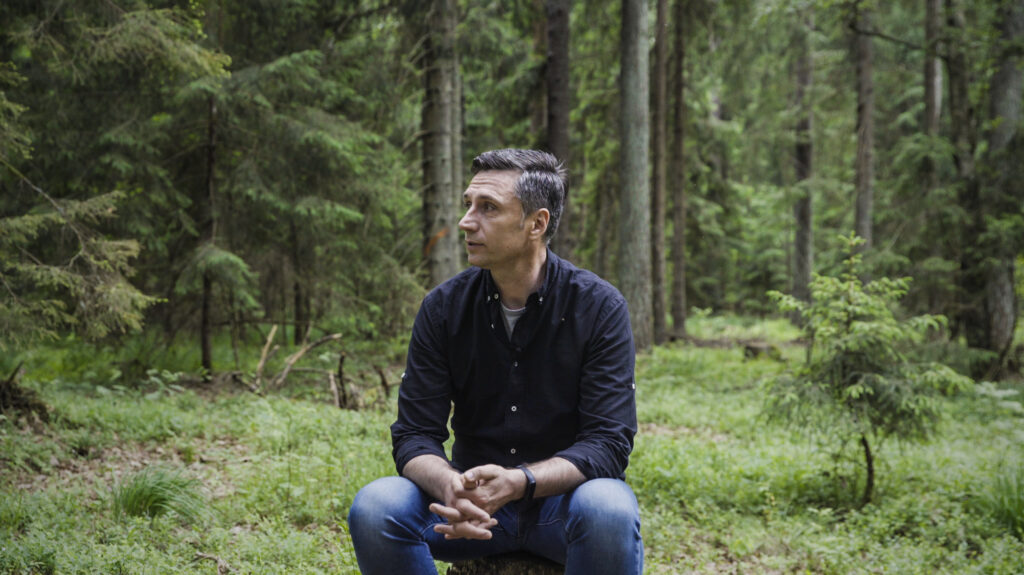
He sits on the edge of a weathered log in a forest near Sokolka, a city near the Poland-Belarus border region where he lives. Navigating the thick undergrowth with ease in jeans and trekking boots, he recounts the first search he coordinated back in February 2022. He received a message on Facebook from a Syrian man in Belarus: “There is a body in the forest, here is the place, please go.”
Piotr was taken off guard. He asked his friends in the police what to do, and they told him the best way was to go himself, take photos, and then call the police. However, the border guards had closed the border region to all non-residents, including journalists and humanitarian workers, so he couldn’t pass the police checkpoints for the area where the body lay.
So Piotr made another call. This time to Rafal Kowalczyk, the 53-year-old director of the Mammal Research Institute, who has worked in the Bialowieza Forest for three decades. (“In my previous TV job, I interviewed him about bison, and thought he was a good man,” said Piotr by way of introduction).
Rafal was up for the task. As a wildlife expert, he had access to the restricted forest area, and now he ventured into the woods not to track bison, but to follow the clues sent by a despairing Syrian man.
In the swamp, Rafal found 26-year-old Ahmed Al-Shawafi from Yemen, barefoot and half-submerged in the water, one shoe in the mud nearby.
It was difficult for Rafal to point his camera at the face of a dead man, but he did, and this image still haunts him. Piotr forwarded the photos Rafal had taken to the police, with a straightforward message: “We know there’s a body there. Now you have to go.”
But what if Ahmed could have been found earlier, even alive?
“The police have no competence”
Until there is a photo of a dead body, police and border guards have often declined to search for missing or dead migrants.
Ahmed’s traveling companions, including the man who contacted Piotr, had personally begged Polish border guards for emergency medical aid for Ahmed. They had left Ahmed by the river in the throes of hypothermia to ask for help. Instead of calling paramedics, or searching for Ahmed at all, the border guards pushed the group back to Belarus, leaving Ahmed to die alone in the forest.
In our investigation, we heard of at least three other deaths that are eerily similar to Ahmed’s: Ethiopian woman Mahlet Kassa, 28; Syrian man Mohammed Yasim, 32; and Yemeni man Dr. Ibrahim Jaber Ahmed Dihiya, 33. In all three cases, traveling companions approached Polish officers for emergency medical attention, but instead got pushed back themselves. Help never arrived.
Each time the activists receive a report of a missing or dead person, they first share this information with the police. Piotr says he has received responses from the police, including, “We’re busy,” or “Not our problem.”
After police were provided with the photos and exact GPS location of Ahmed’s body, they called back to say they still couldn’t find him. When Rafal turned his car around to personally lead the police to his body, he found out why: The police had ventured into the swamp without waterproof boots or even a GPS to navigate in a forest where there is often no cell connection.
“The police are unequipped,” said Rafal, full of disbelief. Two years on from the crisis, the police still do not have the proper basic equipment nor training to conduct searches for people missing or dead in the forest. He recounts that in one trip to retrieve a body with police, they could only walk 300 meters in one hour, and one officer had lost the sole of his shoes in the mud.
The Polish police responded to our email, “The police is not a force with the competence to deal with persons illegally crossing borders.” As a result, eight of 22 bodies found this year on the Polish side of the border were discovered by volunteers like Piotr and Rafal.
On the Lithuanian side, Sienos Grupė says there are not active forest searches. “We are afraid there are many bodies in Lithuanian forests and the area between the fence and Belarus, but we are not allowed there,” says Aušrinė, a 26-year-old medicine student and Sienos Grupė volunteer in Lithuania. “Nobody is looking for them.”
“In two weeks, there is nothing there”
Rafal sits down in a wooden lodge on the edge of the forest and orders tea for himself while his two young children play on a tablet. It was his turn with the kids, he explains in a deep voice. His wife came home at four in the morning, after spending the whole night volunteering with POPH on a search for a man with diabetes in the forest.
He feared that time was running out. We met with Rafal on Thursday evening. The man was found on Saturday morning, already dead. He is the 51st death recorded in Poland this year.
In the forest, each search is a race against both time and wild animals.
The winter may preserve a body for two months, but in the summer, the time frame is much shorter. A few times, Rafal has come across mere skeletons. He explains, “When there is a smell, the scavengers go immediately. When you’ve got summer and flies, probably in two weeks, it’s done, there’s nothing there.”
In such advanced stages of decomposition, the body is exponentially more difficult to identify. However, DNA can be collected from bone fragments, in case families come searching. If they’re lucky, there are objects found close by: glasses, clothes, or jewelry. In one case, a family portrait found near the body was the key to identification.
However, the Suwałki Prosecutor’s Office in Poland explained to us that the Prosecutor’s Offices keep no central register of data on deceased migrants, such as DNA, personal belongings, or photographs.
“As a wife, I know his eyes”
Four and a half months after Samrin disappeared, Sanooja’s phone rang. It was January 5, 2023. She will never forget the voice of the man that spoke. He was calling from the Ministry of Foreign Affairs in Sri Lanka, and informed her that her husband’s DNA had been matched to a body found in the Lithuanian forest. Interpol had drawn Samrin’s biometric data from the UK.
She considers it fate that the dots came together this way. When they were 20 years old, Samrin’s father passed away, and Samrin left for London on a student visa. Instead of studying, he washed dishes at McDonald’s and KFC, and stocked shelves at Aldi, Lidl, and Iceland. When his visa expired, he lived a clandestine existence, evading the authorities. At age 26, the Home Office arrested him, took his DNA, and deported him. This infraction turned out to be an unexpected lifeline for his identification.
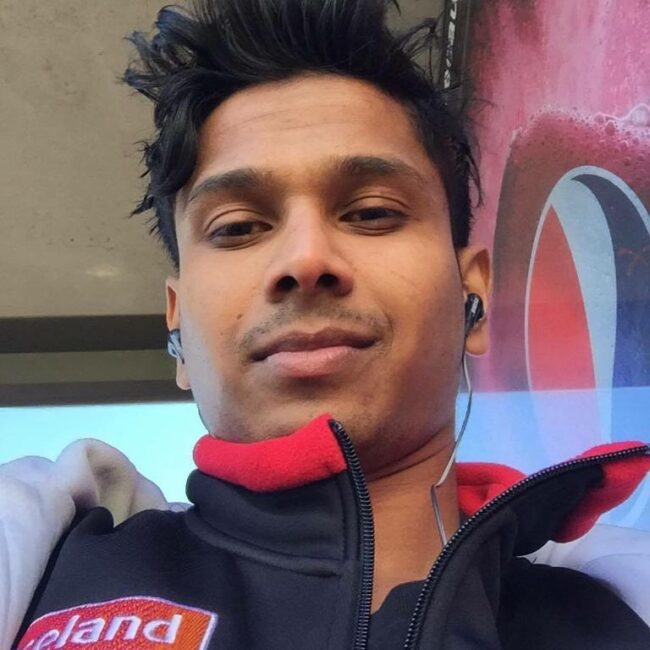
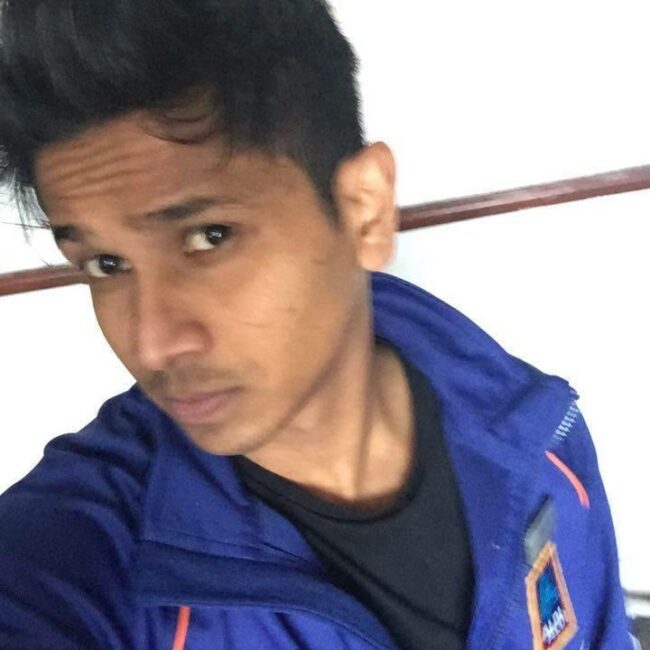
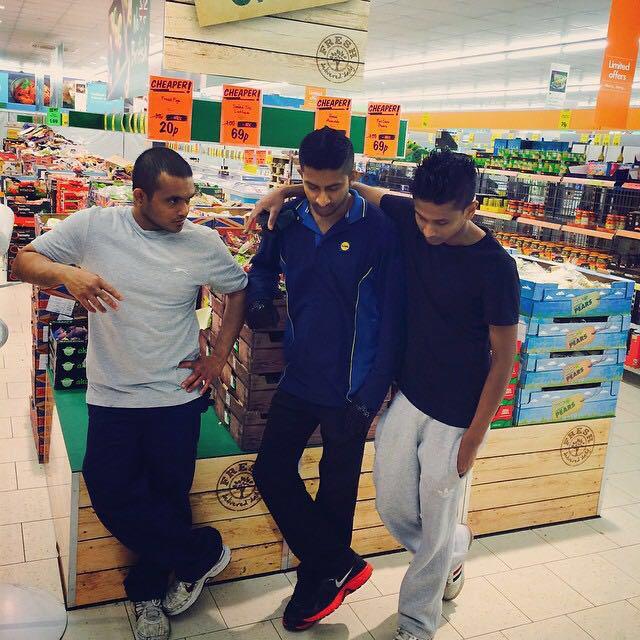
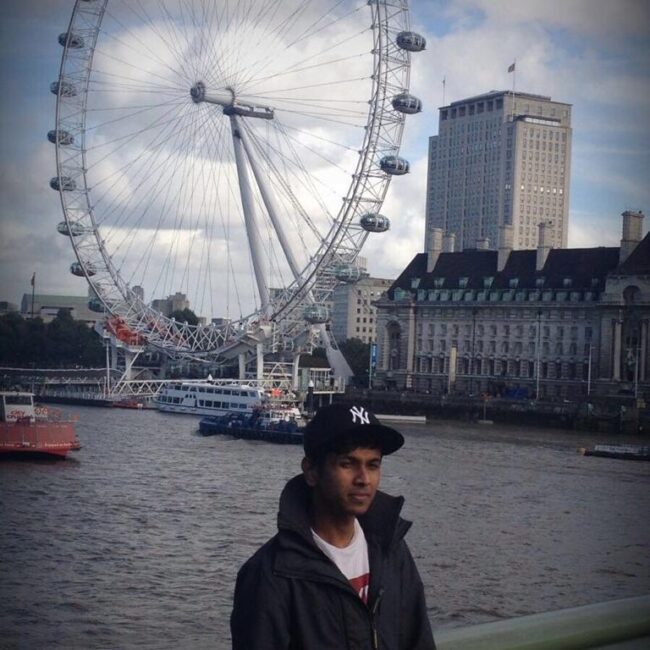
Samrin’s life in London. He worked at supermarkets such as Aldi and Lidl. Photo: Shared by family.
“Getting the message that my husband was no more, that was nothing compared to those four and a half months,” said Sanooja. She had begun to fear that she would have to live with “lifelong doubt” around Samrin’s fate. Now she knew that four days after Samrin sent his goodbye message, his body was pulled from a river on the Lithuanian side of the border.
Sanooja has read the police report countless times now: On August 21, 2022, witness Saulius Zakarevičius went for a morning swim in the Neris River. After bathing, he saw something floating. Through binoculars, he was able to decipher human clothes. The river bank is covered with tall grass. At the end of the patch there was a male corpse lying face down. The surface of the skin was swollen, pale, chaotically covered with pink lines, resembling the surface of marble. The skin was peeling from the palms of the corpse…
She was asked to identify the corpse.
“As a wife, I know him. I know his eyes. To see them on a dead body, that was terrible.”
Sanooja
In photos of his personal items, she instantly recognized Samrin’s shoes: a muddy pair of blue Converse All-Stars, with the laces looped just the way he always did.
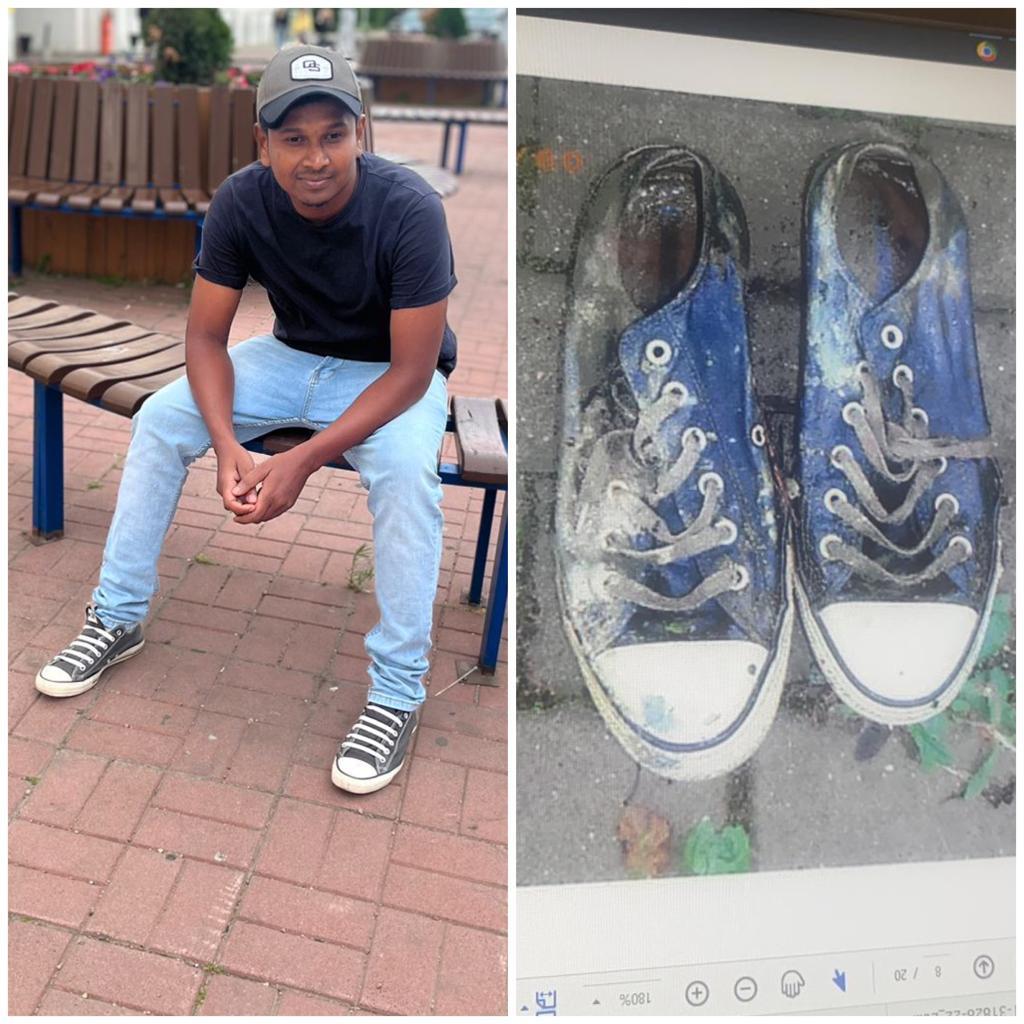
To be able to transport a dead body from Europe to any other part of the world, families must face the financial challenge of costs up to 10,000 euros. But the decision was not only about money for Sanooja. It was about time and dreams.
For one, she believed that he had suffered enough. “As Muslims, we believe that even dead bodies can feel pain,” she says softly. “I felt broken that he was in the mortuary, feeling the cold for four and a half months.”
And perhaps most of all, she recites what Samrin had told her before he left: “If I go, this time I’m not coming back.” In the end, Sanooja relied on her husband’s last will. “His dream was to be in Europe. So, at least his body will rest in Europe.”
“Graves without a plate”
Samrin’s death was the first border death publicly recognized by the Lithuanian government. Despite being the first, he did not receive any distinctive attention, and his resting place remained an unmarked mound of earth for more than eight months.
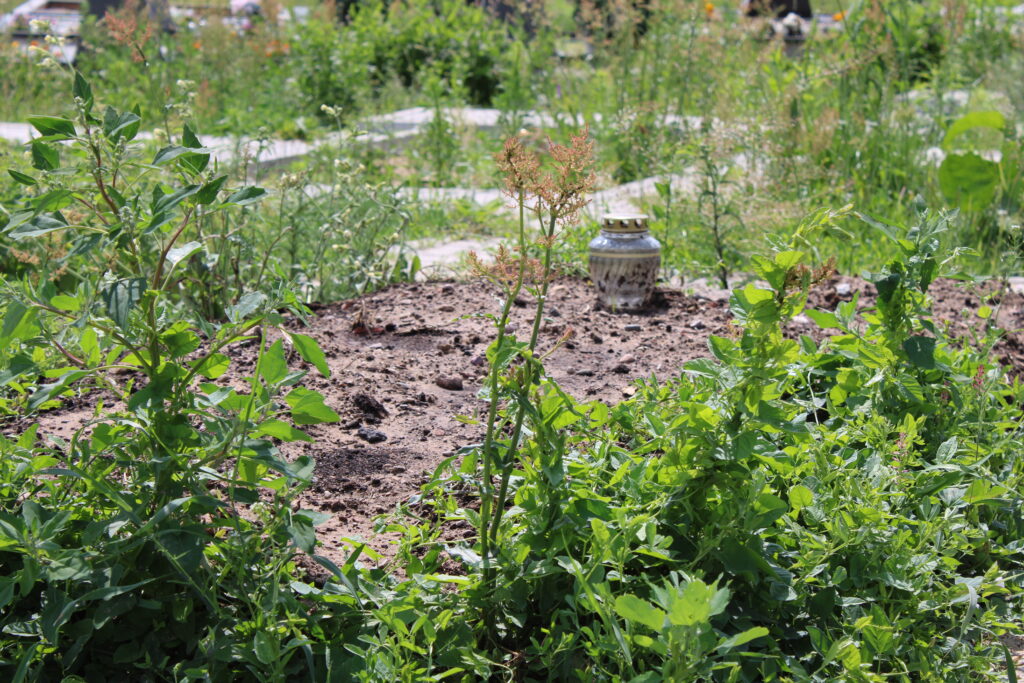
On a hot summer day in July, co-founder of Sienos Grupė, Mantautas Šulskus brings a green watering can and measuring tape to our visit to the Vilnius cemetery where Samrin was buried in February. Green grass is sprouting all over Samrin’s grave. But it is not the only one.
There are three smaller graves lined in a row. Among them, an eleven-year-old, a five-year-old, and a newborn baby rest side by side, their lives cut short in 2021. “These are three minors who died in detention centers in Lithuania,” Mantautas points out somberly.
These cases have not been officially acknowledged by Lithuanian authorities, and none of the graves of the minors bear a name, even though their identities were also known to authorities. This lack of recognition paints a haunting picture, suggesting a second, silent death—a death of identity and acknowledgment.
Bodies are sent to municipal or village governments to bury, and if they do not receive explicit instructions to create a plate, they often opt not to. As a result, the nameless graves of migrants are scattered across cemeteries in the region.
Yet Mantautas is here in the scorching heat to measure a stone plate nearby in the Muslim corner of the cemetery. Sanooja saw it during a video call with Sienos Grupė volunteers, so that she could pray virtually at her husband’s grave. She asked for a plate with Samrin’s name on it—“just exactly like that one there,” she pointed.
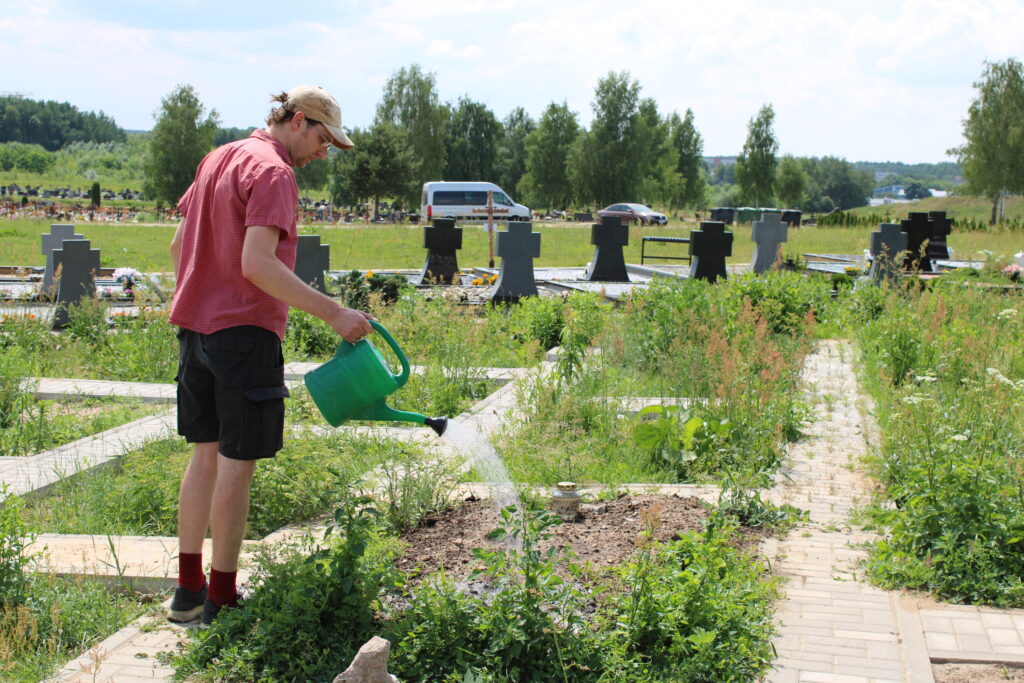
After some months, Sienos Grupė crowdfunded around 1,500 euros to buy and place stone plates for all four graves. The graves of Samrin and the three children now have names: Yusof Ibrahim Ali, Asma Jawadi, and Fatima Manazarova.
Resting at the feet of the grave is a plate made of stone bearing the inscription “M.S.M.M. Samrin, 1990-2022, Sri Lanka,” precisely as Sanooja has requested. She explains that, according to Islamic beliefs, this will ensure that her husband will rise when the last days come.
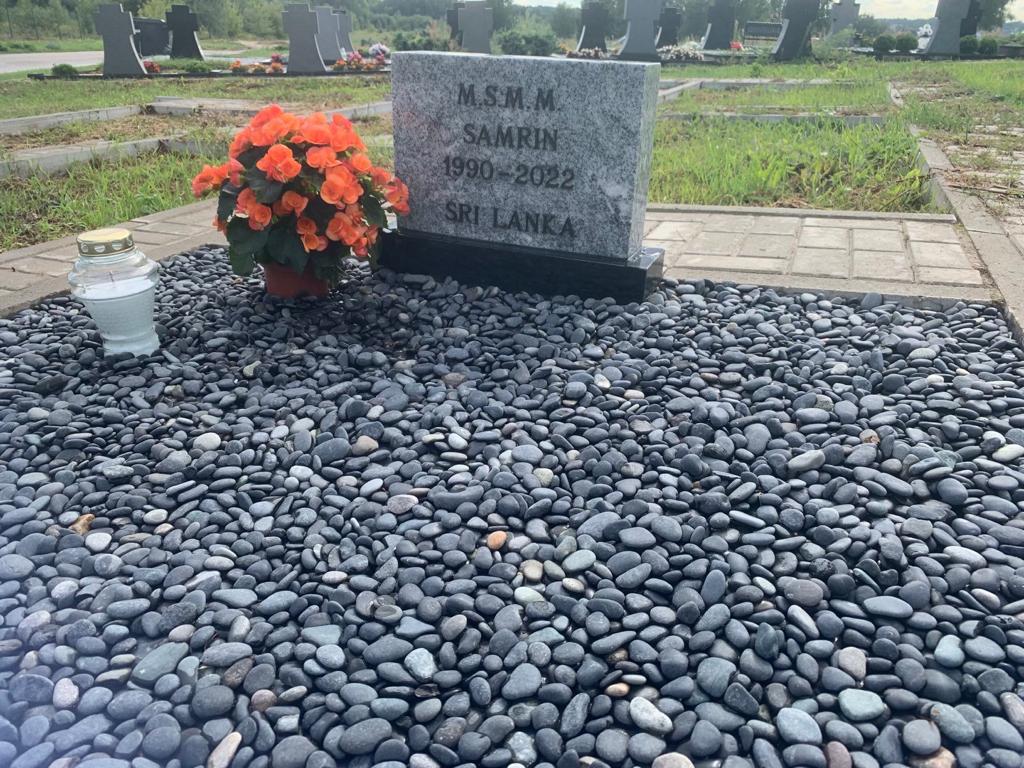
Hidden graves, unknown bodies
The chilling thing, Mantautas explains, is nobody knows how many graves of migrants there might be, except for the government, which buries them quietly, often in remote villages.
Organizations like Sienos Grupė find themselves grasping in the dark for leads. Last month, volunteers came across the grave of Lakshmisundar Sukumaran, an Indian man reported dead in April “quite by accident,” says Mantautas. The revelation came on the Eve of All Saint’s Day, when activists preparing for a patrol ran into a local returning from a visit to his mother’s grave: “There is a migrant buried in town.”
Indeed, Sukumaran’s grave stands alone in an isolated corner of a small cemetery in Rameikos, a village of 25 people on the Lithuanian-Belarus border. Set apart from crosses of various sizes, a vertical piece of wood bears the inscription: “Lakshmisundar Sukumaran 1983.06.05 – 2023.04.04.” The border fence is visible from his grave. The earth is decorated by the colorful leaves of Lithuanian autumn.
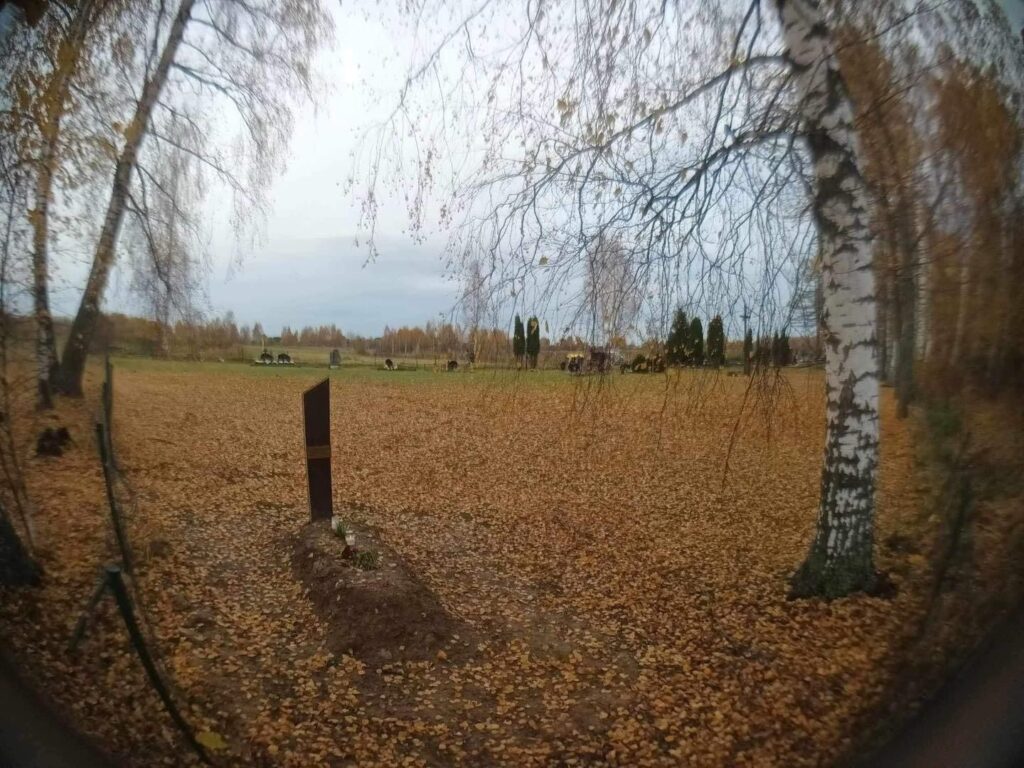
Sienos Grupė maintains a list of people reported missing on the Lithuania-Belarus border, the number changes “every day”. As for the time of this publication, at least 40 people are on this list, information the government does not record. When bodies are found, they strive to connect the dots: Location, gender, age, ethnicity, possessions, birthmarks, anything. But if authorities do not report when a body is found, the chances of locating anybody on this list are small.
Emiljia Śvobaitė, a lawyer and volunteer from Sienos Grupė, explains that the Lithuanian government will only confirm whether something they already know is correct. “It seems like they are hiding these kinds of stories and information unless somebody exposes it. They would only confirm the deaths after activists have said something about it.”
“No political will”
The Lithuanian Parliament building, known as the Seimas Palace, is an imposing glass-and-concrete building in downtown Vilnius. It is where the Lithuanians declared independence from the Soviet Union in 1990. From an office with a view over the square, Member of Parliament Tomas Tomilinas wryly explains that their government has legalized pushbacks essentially because Europe has not established that it’s illegal.
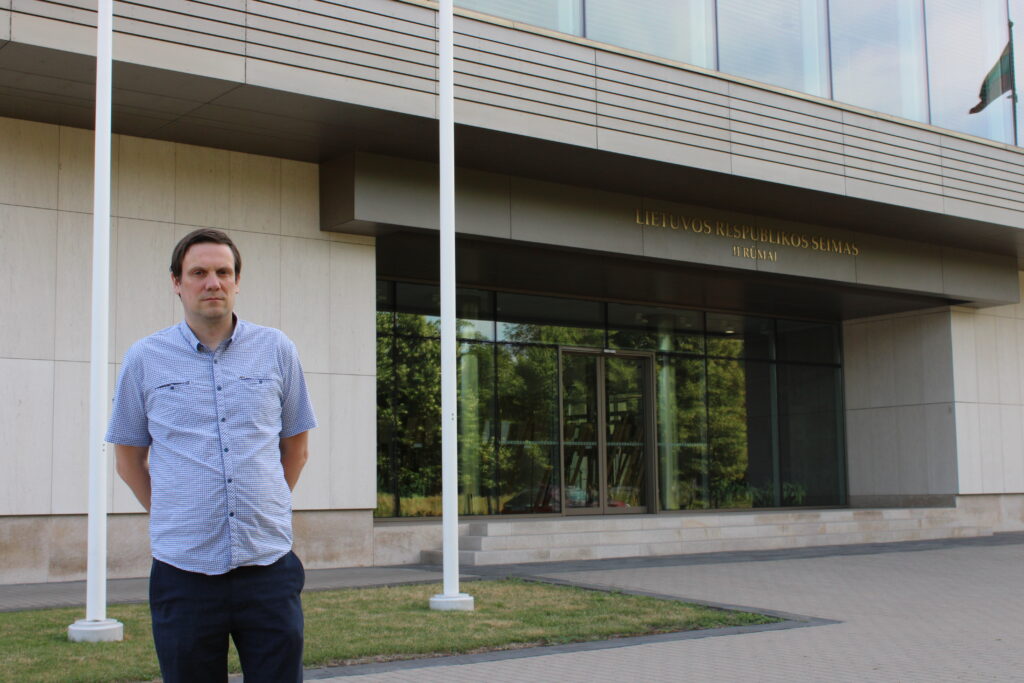
“I would say Europe has no political will to make pushbacks illegal. If there were a European law, the European Commission would put a ban on it. It would put a fine on Lithuania. But nobody’s doing that.”
Member of Lithuanian Parliament, Tomas Tomilinas
The Polish parliament legalized pushbacks in October 2021, and the Lithuanian parliament followed suit by legalizing pushbacks in April this year.
Emiljia raises concerns about the violence of pushbacks her clients have seen. “The government keeps telling us they do everything really nicely. They give people food, and even wave goodbye to them, in the daytime. But when we look at specific cases, where people end up without their limbs on them, those pushbacks are performed at night.”
She also raises concerns about legalized pushbacks in Lithuania, and whether border guards should be given the right to assess and deny asylum claims on the spot. “It’s funny because border guards should decide right away on the border whether a person is running from persecution, meaning a border guard should identify the conflict in the country of origin, and do all the work that the migration department is doing.”
“It’s naive to believe that the system would work.”
Fighting back in court
With the help of Sienos Grupė’s support for legal expenses, Sanooja took the case to court. If the Lithuanian officials wouldn’t speak with her, perhaps they would speak to lawyers.
Yet last month, Sanooja’s case was closed for the final time by the Vilnius Regional Prosecutor’s Office after seven appeals. The case never made it to trial.
The Vilnius court claims there is no basis for a criminal investigation. Emiljia, who was on the team representing Sanooja in the case, responds that the pre-trial investigation didn’t investigate the cause of death properly, nor how the acts of the border police might have caused or contributed to the death of the applicant’s husband.
Rytis Satkauskas, law professor, managing partner of ReLex law firm, and the lead attorney on Sanooja’s case, questions whether the Lithuanian courts are trying to hide something greater: he points to a series of inconsistencies in Samrin’s autopsy report.
Autopsies should be conducted immediately to determine the cause of death. However, Samrin’s autopsy report claims that the cause of death cannot be established because the body was in an advanced state of decomposition of up to five months.
Five months after Samrin’s death is the same time around which Sanooja got in touch to pursue the truth of the matter. Satkauskas does not think this is a coincidence: “I believe they left the body in the repository, then when they established the identity of the person, they had to do this autopsy.”
The autopsy report explains the advanced state of decomposition by referencing the marshy area in which it was found, claiming the heat of the marsh had accelerated decomposition by up to five months within a matter of days.
Satkauskas asks further: If Samrin simply drowned, then why do other measurements not add up? He references a table of measurements in the autopsy report, in which the weight and algae content of the lungs are normal. However, Satkauskas says, in cases of drowning, both weight and algae content should be much higher. “I’m convinced they have invented all those measurements,” Satkauskas puts simply.
As Sanooja’s case has exhausted all legal avenues in Lithuania, it is now eligible for appeal to the European Court of Human Rights.
Emilija points to a promising parallel: in Alhowais v. Hungary, the European Court of Human Rights ruled this February that a Hungarian border guard’s violent pushback ending in the drowning of a Syrian man violated Articles 2 and 3 of the European Convention of Human Rights, which protects the “right to life” and against “torture or inhuman or degrading treatment or punishment.”
The decision came in February this year, seven years after the death of the defendant’s brother. Yet for Sanooja and her team, the case provides hope that there is a growing legal precedent for victims of pushbacks.
A battle in court for Sanooja could be a long and expensive one. The case in Vilnius courts had cost 600 euros for each of the seven appeals, and after Sanooja ran out of funds after the first case, Sienos Grupė stepped in to shoulder the costs of the appeals.
For the ECHR, it will cost 1500 euros to submit the proposal. Sanooja is exploring the possibility of raising money through NGOs or other means to continue the long quest for truth.
The window of eligibility to appeal will close in February 2024.
“Wherever I go, I have memories”
Day by day, Sanooja’s son grows to look more like Samrin.
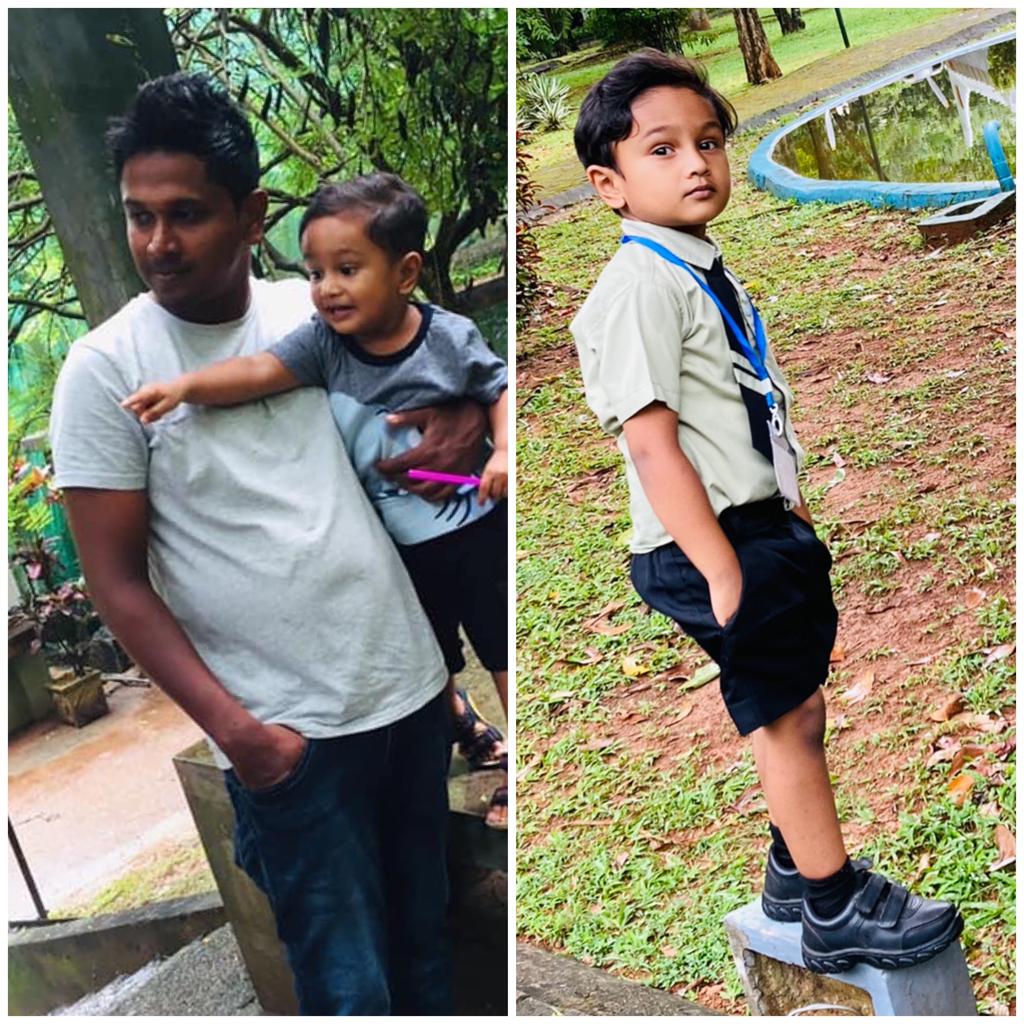
She has tried not to cry in front of him. “It makes him upset. I am the only person now for my son, so I should be strong enough to face these things,” says the 32-year-old widow. “But wherever I go, I have memories. And everything my son does reminds me of him.”
Before Samrin’s body was found, she told her son “false stories,” but with his body now interred, she has opened up to her son about her father’s death. He understands it the way a child might—he runs around telling neighbors his father is in heaven, and it’s a great place. It will be years before he can point to where Lithuania is on a map.
Thanks to the cooperation of the Sri Lankan embassy in Sweden, Sanooja is one of the few families who have been able to receive a death certificate. She notes this will be crucial when her son enrolls for school and if they decide to sell or expand their property. However, to correct the misspelling on the document, she needs to travel to Colombo, the capital of Sri Lanka, which takes ten hours and nearly 10,000 rupees.
Meanwhile, Samrin’s death has ruptured the family into those who can accept the reality of his death, and those who cannot. Sanooja’s mother-in-law has ceased contact with her, unable to wrap her head around the fact that her boy is gone. When Samrin had left, he promised his mother to send money so that she would no longer have to wake up early to make pastries to sell in the morning. On the day of Samrin’s funeral, she told the family, “That is not my son.”
“What difference does it make, finding the body and burying it?” asks Pauline Boss, the Psychology Professor emeritus at the University of Minnesota who coined the term “ambiguous loss,” which encompasses the unique stress of not knowing whether someone you love is alive or dead.
Professor Boss states that burying someone is a distinct human need—not just for the dead, but for the living. “In all cases, a human being has to see their loved one transform from breathing to not breathing, and have the power and control to deal with the remains in their particular cultural way. It’s a human need, and it has been for eons.”
Yet few families are able to attend the funerals of their loved ones in Europe, for the same reason their loved ones tried to travel to Europe on such a dangerous road in the first place: inability to obtain a visa, or lack of funds.
“I hope one day I will visit, and I will show our son his father’s grave,” Sanooja declares.
When Samrin was interred into the snow-covered February earth of Liepynės cemetery in Vilnius on Valentine’s Day this year, a volunteer present at the burial offered to video call Sanooja through FaceTime.
In the grainy constellation of pixels of the phone screen in her palm, from 8,000 kilometers away, she watched her husband disappear forever into the cold European soil.
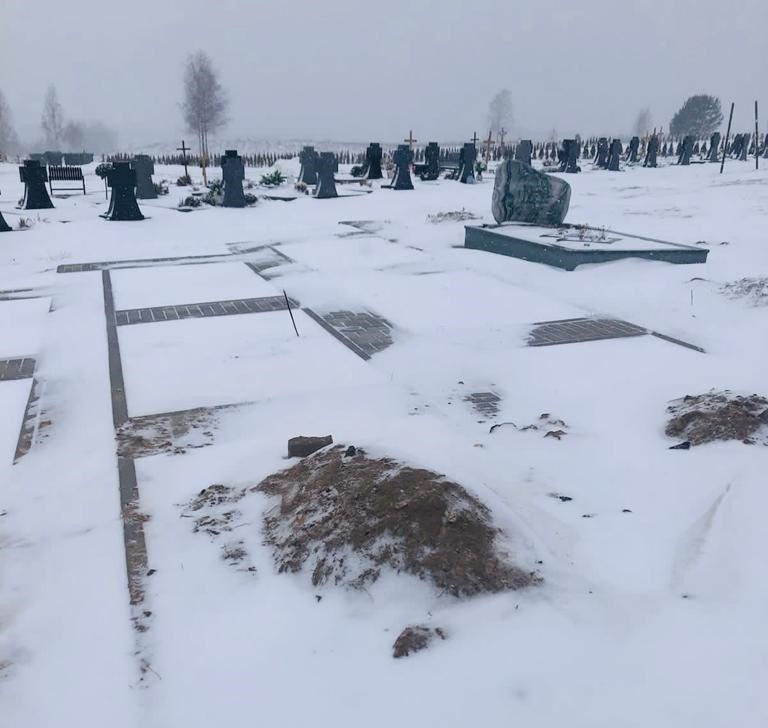
About the authors:
Gabriela Ramirez is an award-winning multimedia journalist specializing in migration, human rights, ocean conservation, and climate issues, always through a gender-focused lens. Currently serving as the Multimedia & Engagement Editor at Unbias The News.
Tina Xu is a multimedia journalist and filmmaker working at the intersection of migration, mental health, socially engaged arts, and civil society. Her stories often interrogate the three-way street between people, policy, and power.
About the investigation:
This article is part of the Border Graves Investigation, made in collaboration with The Guardian and Süddeutsche Zeitung. The Border Graves Investigation team consists of Barbara Matejčić, Daphne Tolis, Danai Maragoudaki, Eoghan Gilmartin, Gabriela Ramirez, Gabriele Cruciata, Leah Pattem, and is coordinated by Tina Xu. This investigation was supported by Investigative Journalism for Europe and Journalismfund Europe. Additional support by Limelight Foundation.
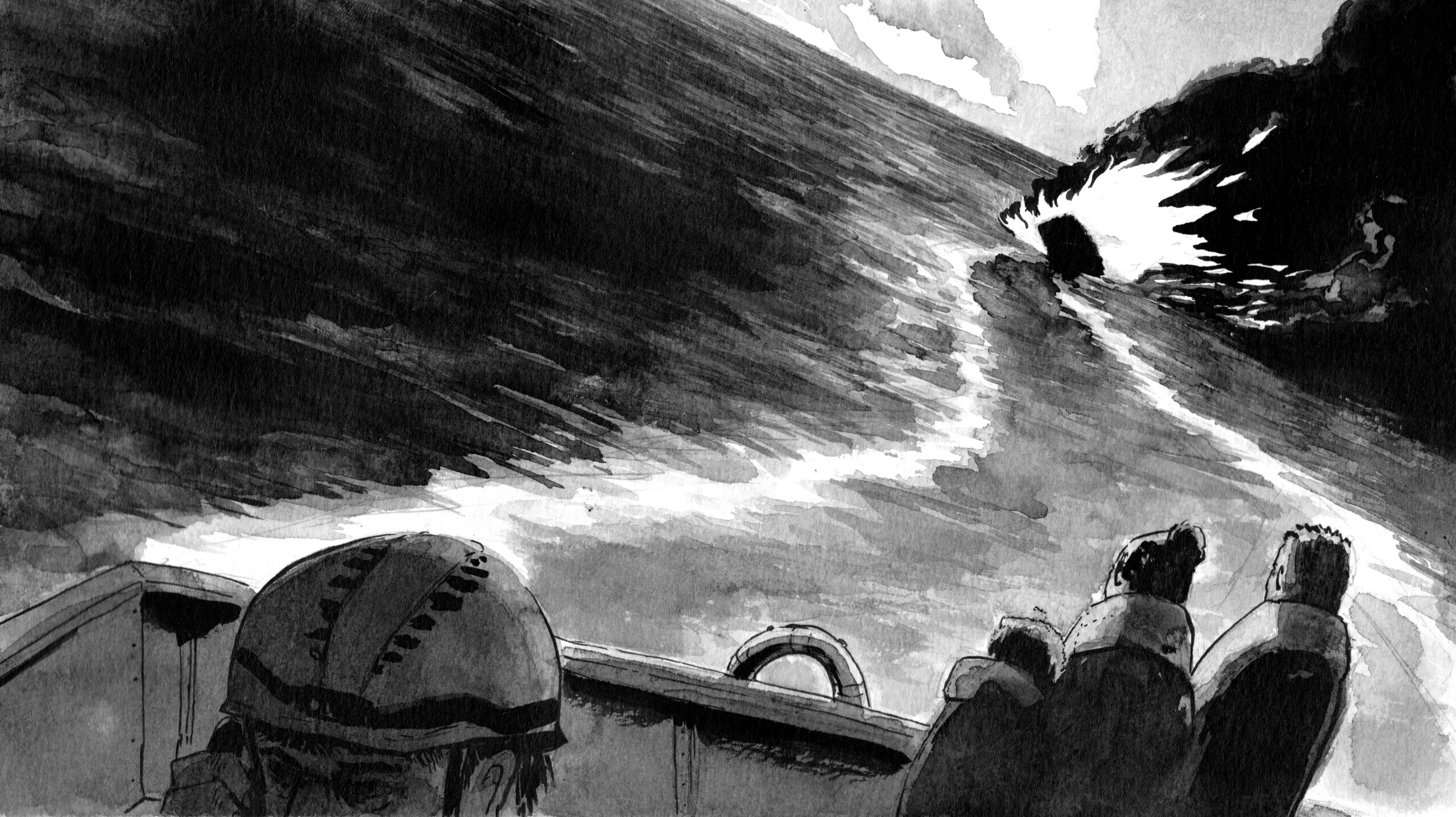
From 2013 to the present, Refaat has searched everywhere for their children. For ten years he has been traveling, asking, and searching. He has even appeared on TV hoping one day to be reunited with them. But to this day he still does not know if his children were saved or if they are two of the 268 victims of the October 11, 2013 shipwreck, one of the worst Mediterranean disasters in the last three decades.
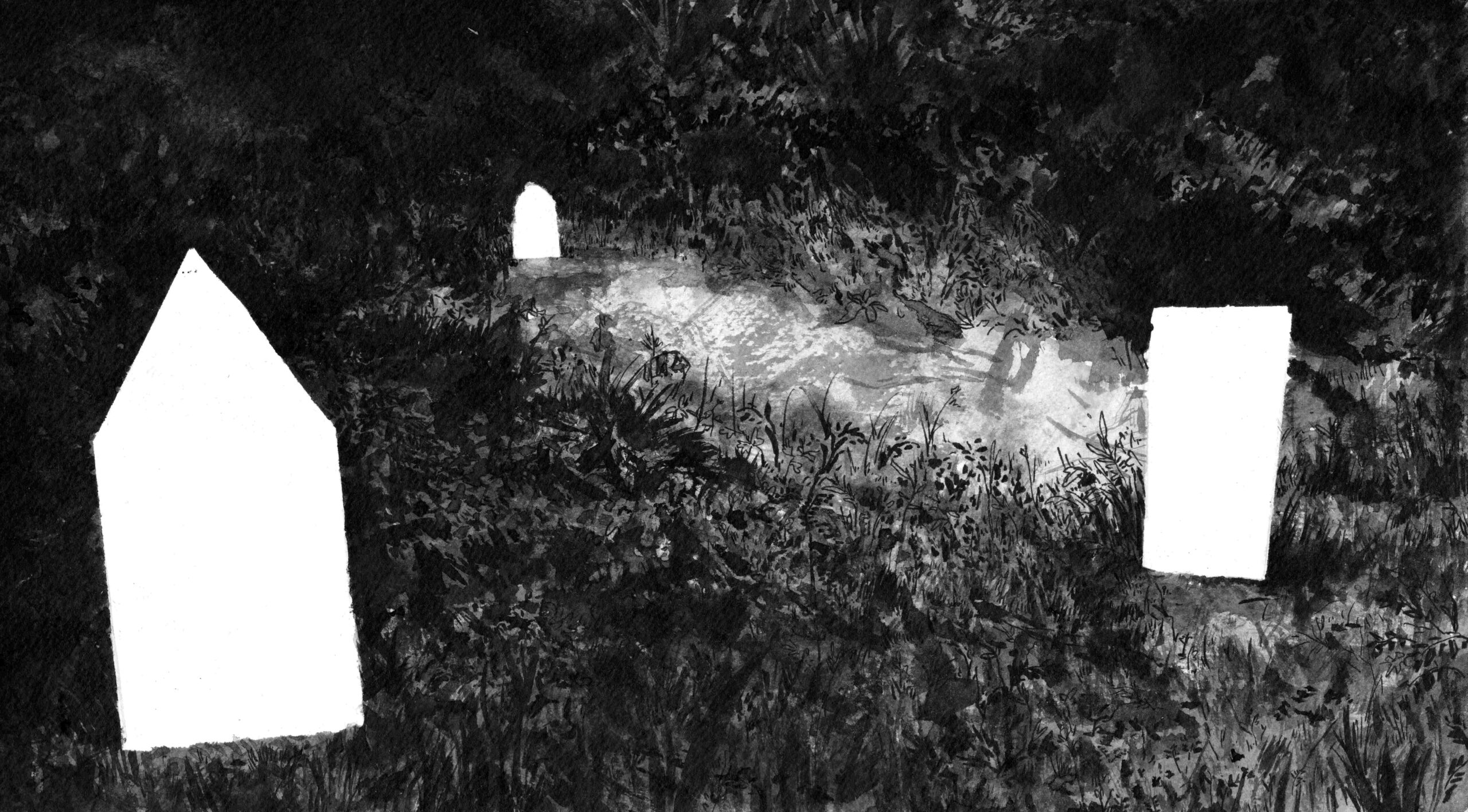
“My wish is that even 100 years from now these graves stand as monuments of the EU’s shame. Because it was not the river that killed these people, but the EU border regime.”
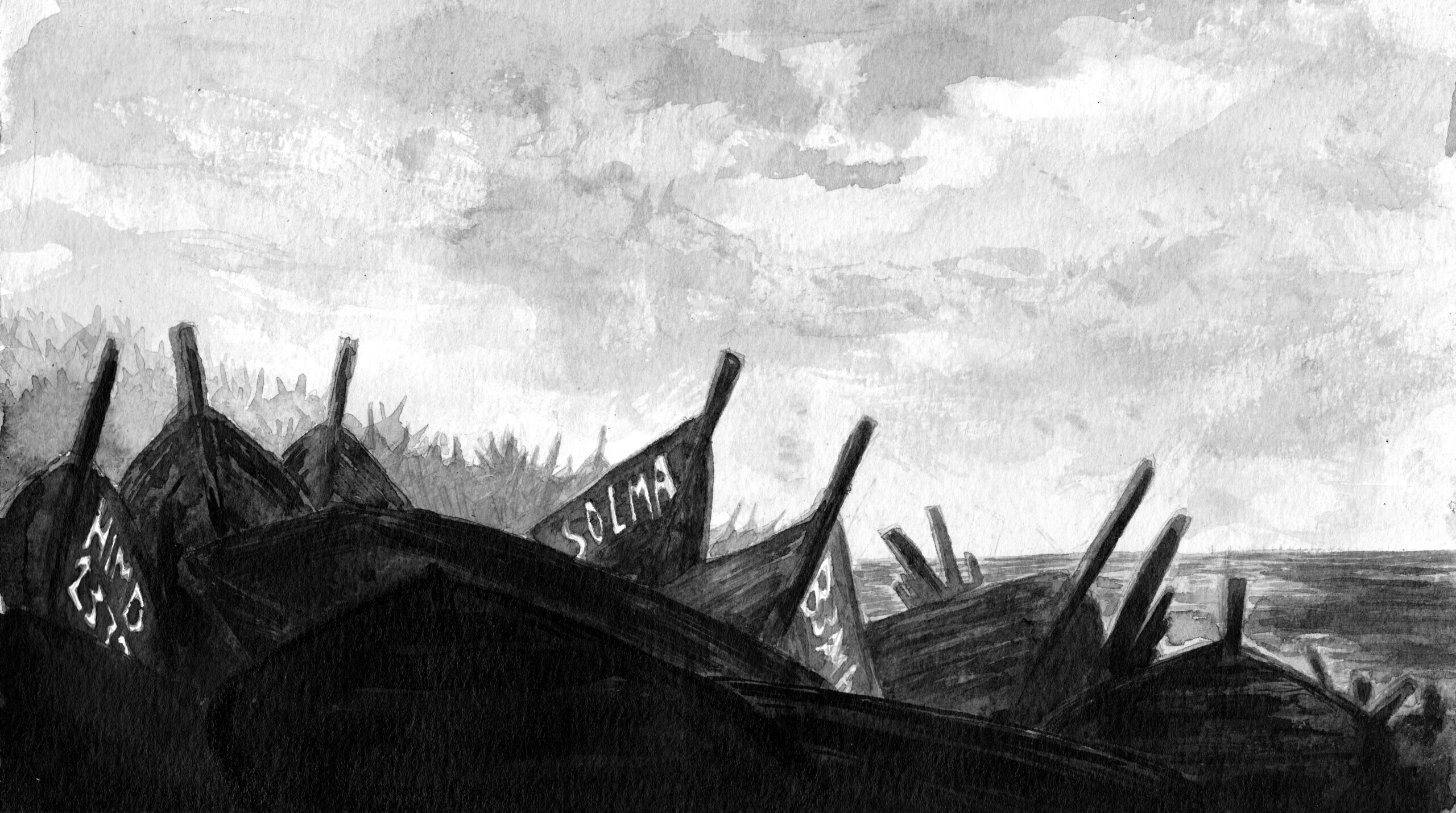
No one ever comes to visit, but on days when there are funerals here and flowers are about to be thrown out, I place them on the tombs containing the unknown migrants,” he explains. “In some of the older graves, you have the remains of up to five or six migrants together, each placed in separate sacks within the same niche to save space.”
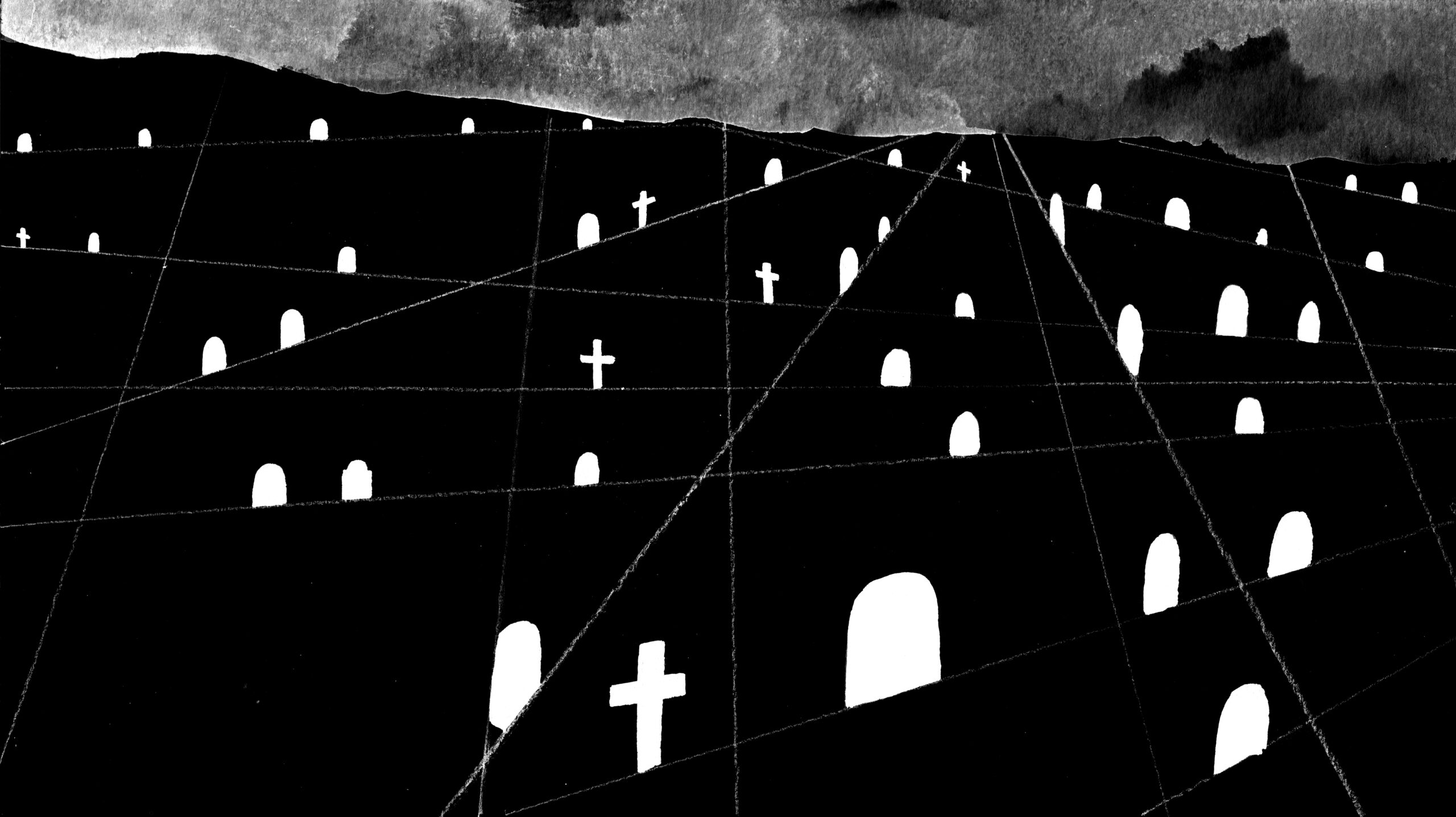
Latsoudi recalls something a refugee had mentioned to her in 2015: ‘The worst thing that can happen to us is to die somewhere far away and have no one at our funeral’.

